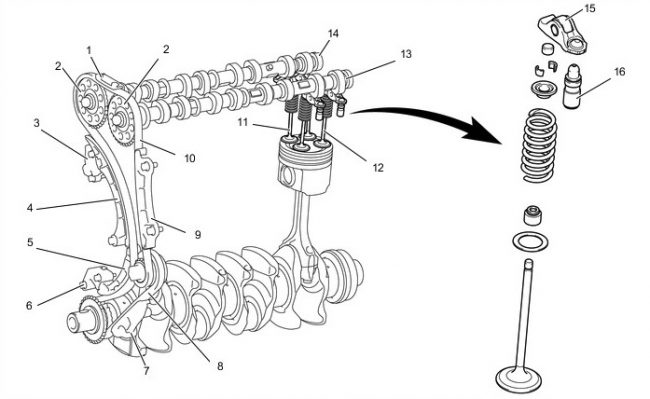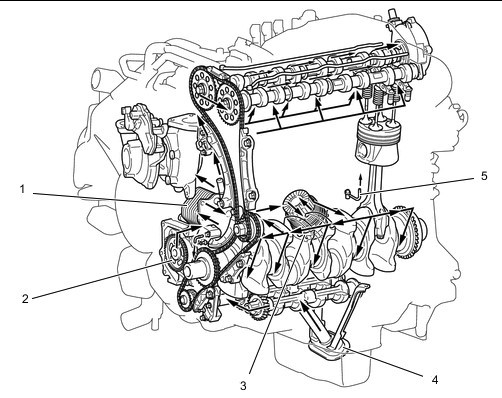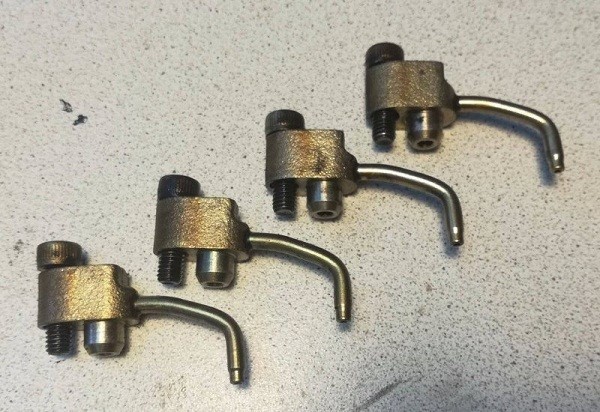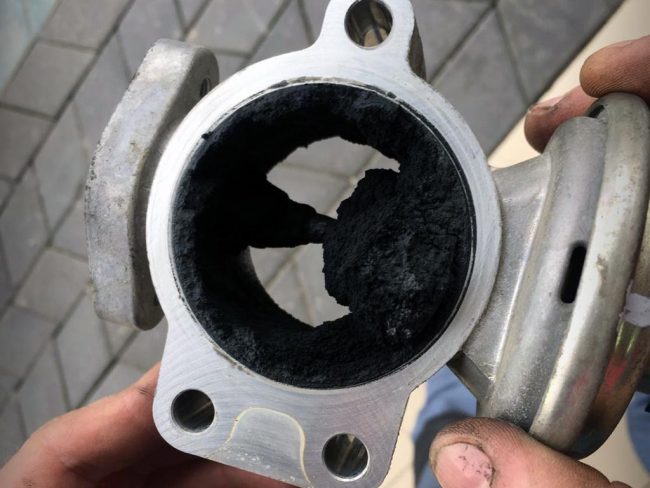
Toyota 1GD-FTV engine
Content
To replace the outdated series of KD engines, Japanese engine builders have proposed samples of new power units 1GD-FTV and 2GD-FTV. The 1GD-FTV turbodiesel engine was built from the ground up. Initially, its installation was planned only on the Land Cruiser Prado, but subsequently the application was somewhat expanded. The founder of the new Global Diesel (GD) series has incorporated all the best and advanced in the field of engine building.
Description and history of creation
Engines of the KD series have proven themselves not from the best side. Especially in matters of economy and the requirements of environmental standards. Unsatisfactory specific characteristics, high noise during operation and a number of other negative factors made Japanese engineers face the need to develop a new internal combustion engine.
Given the shortcomings of the KD series, in 2015 Toyota developed and introduced a new 1GD-FTV turbocharged diesel engine into production.

According to the manufacturer, the 1GD-FTV power unit, due to the optimization of the fuel combustion process, has become 15% more economical than its predecessors. At the same time, the torque was raised by 25%. And, most amazingly, the level of nitric oxide in the exhaust gases is reduced by 99%.
The cylinder block is cast iron, non-sleeved. For cars of the Prado and Hiace line, it is adapted to accommodate the balancing mechanism. HiLux models do not have such a device.
The cylinder head is made of aluminum alloy, covered with a plastic cover.
The pistons have undergone significant improvements. The head has a channel for cooling.

The combustion chamber has been significantly optimized. The piston skirt has an anti-friction coating. The groove for the top compression ring has a special insert. The piston head is treated with a thermal insulating compound (porous anodic alumina).
The gas distribution mechanism (timing) is made according to the DOHC 16V scheme.


Valve operation is carried out by means of two camshafts with a chain drive from two chains.
The drive of the hinged equipment is belt.
The presence of oil nozzles in the lubrication system has led to an improvement in both lubrication of the pistons and their cooling. Thanks to this innovation, piston cracking, as in the KD series internal combustion engines, has gone down in history.

![]()

The air intake system is equipped with a compact turbine (dimensions have become smaller by 30%). The variable geometry of the guide vane ensures that the optimum air pressure is maintained at any speed of the crankshaft. Turbine cooling liquid. The charge air is additionally cooled by a front intercooler. The change in the shape of the intake channels, the symbiosis of the new turbine and intercooler increased the efficiency of the air intake system by 11,5%.

The Common Rail fuel system provides an injection pressure of 35-220 MPa. Fuel injection takes place twice. This achieves its complete combustion. The result is an increase in power, a decrease in exhaust toxicity, ensuring optimal fuel consumption and creating favorable conditions for maintaining the temperature regime.
Bringing exhaust gases to Euro 6 environmental standards is ensured by:
- oxidative neutralizer (DOC);
- particulate filter (DPF);
- SCR and ASC catalyst system.
Additionally, the exhaust gas recirculation (EGR) system reduces the emission of nitrogen oxides. At the same time, the SCR system "adjusts" the exhaust to Euro 6 standards by injecting a urea solution.
Another novelty turned out to be useful for the user - active engine mounts. Now the motor has become quiet, without feeling the previously annoying vibration. Such a system is widely used on cars of the Prado family.
Specifications of the 1GD-FTV engine
| Engine volume, cm³ | 2755 |
| Power, hp | 177 |
| Torque, N/m | 420-450 |
| Compression ratio | 15,6 |
| Number of cylinders | 4 |
| Cylinder diameter, mm | 92-98 |
| The piston stroke, mm | 103,6 |
| Valves per cylinder | 4 |
| Valve drive | DOHC 16V |
| Fuel | Diesel (DT) |
| Fuel injection system | Common Rail |
| Nozzle | Dense* |
| Turbocharging | VGT or VNT |
| Fuel consumption (city/highway/mixed), l/100 km | 9,2/6.3/7,4** |
| Oil volume, l | 7,5 |
| Oil used | ACEA C2 (0W-30)*** |
| Environmental indicator | Euro 6 |
| Weight including filling with working fluids, kg | 270-300 |
| Approximate resource, km | 250000 |
Values marked with an asterisk must be specified in the Vehicle Operating Instructions.
Reliability, weaknesses, maintainability
The vast majority of Toyota car owners note that the 1GD-FTV engine is a reliable unit, but subject to the manufacturer's recommendations. Nevertheless, the weaknesses of the internal combustion engine are still rare, but they appear. The most problematic nodes and parts are:
- particulate filter (clogging);
- glow plugs (destruction);
- camshafts and rockers (increased wear);
- fuel pipe between injection pump and rail (weak fastening).
The last two faults are recognized by the company as its flaw. Cars assembled in Japan (March-June 2019) responded to the elimination of the defect. The problem of clogging the particulate filter is caused by the complexity of auto-regeneration.

It was recommended to replace the firmware, install a forced regeneration button.
In any case, periodic cleaning of the intake tract and the EGR valve is necessary for every modern diesel engine.
To eliminate the causes leading to the destruction of glow plugs, it is also recommended to change the firmware.
At the same time, the listed malfunctions can be caused by the low quality of our diesel fuel. Especially when refueling is carried out from unverified sources. (On this occasion, the issue of the safety of using diesel fuel for diesel locomotives and ships was repeatedly discussed at various forums).
So far, there is no information about maintainability, since the engines have been operated for a relatively short period of time. But judging by the fact that the cylinder block is made of cast iron, we can conclude that the 1GD-FTV engine is maintainable.
Tuning
On Toyota cars, it is possible to increase the power of the 1GD-FTV power unit to 225 hp. At a specialized car service, such work is done quickly. But the most important thing is that after skillfully performed tuning, the work resource laid down by the manufacturer is preserved and the dealer warranty is preserved.
The chip tuning process consists in flashing the electronic control unit, turning off the EGR valve in the exhaust gas recirculation system. (The valve is responsible for burning soot particles formed during the combustion of fuel).
After tuning, the motor acquires increased power (225 hp) and an increase in torque up to 537 N / m (instead of 450 before). Such changes have a positive effect on the "behavior" of the machine:
- the power reserve is significantly increased, which is important when overtaking on the highway;
- fuel consumption is reduced;
- pauses disappear when you press the gas pedal;
- smooth gear shifting (automatic transmission) is noted.
In addition, car owners noticed a slight reduction in acceleration time to 100 km / h (by 2 seconds).
Improvement of the motor by the concern
Toyota engine builders did not stop at the success achieved and continued to develop improvements to the 1GD-FTV. The first trial batch has been made. The main difference from its predecessor is the increase in power to 204 hp. Torque increased by 50 N/m to 500 N/m.
The new engine is made for the Toyota Fortuner SUV line. According to available information, a modification of Toyota Hilux pickups is being prepared for equipping with such internal combustion engines.
Thus, we can conclude: the quality of the new Japanese diesel engine fully satisfies all the needs of our consumer. Subject to all the recommendations of the manufacturer, the new motor serves for a long time and without fail. As always, the Japanese engine builders were on top.
What cars is installed

